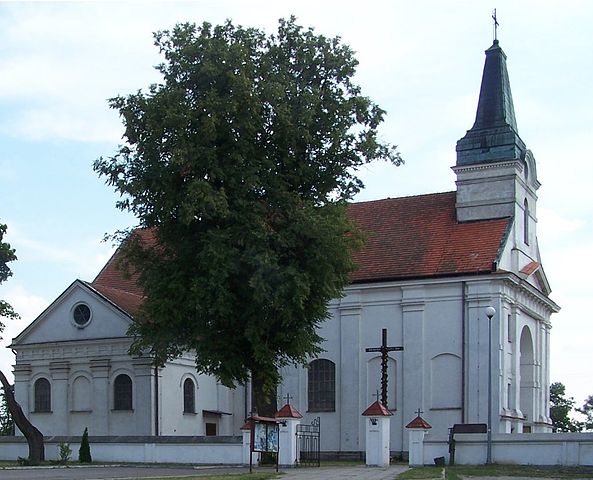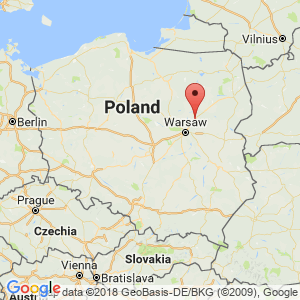Wyszków

St. Idzi's Church in Wyszków. – Photo by: anonymous, Wyszkow-SwIdzi-2006 Ejdzej, CC BY-SA 2.5
Distance
46 km SV, 61 km SE, 79 km N, 39 km NE, 90 km V, 29 km NV, 59 km SV, 48 km SE, 71 km NEPopulation
27.074 (2016)
Location and history
The town of Wyszków is located in eastern Poland, northeast of Warsaw, on the Bug river.
Wyszków is located on the high right bank of the Bug River. The city's name is thought to be derived from the first name Wysz and its form in diminutive: Wyszko. The name probably belonged to one of the owners of the settlement in ancient times.
At the end of the 11th century, under King Bolesław II Śmiały, the entire forest area belonged to Puszca Biała, including the settlement, later named Wyszków, north of the Bug river, the bishops of Płock. In the last years of the 11th year. allowed the bishop to build a church in Wyszków, consecrated to St. Idzi (Latin: Aegidius). The name Wyszków is first mentioned in the sources in 1203.
In 1501, Bishop Wincenty Przerebski was granted permission by King Jan Olbrecht to grant Wyszków a town court and thus town rights, and this happened in 1502. The bishops of Płock built a summer residence here, a mansion located in the village of Nadgorze just outside the city limits (today a street in Wyszków). Bishop Karol Waza chose to settle permanently in Wyszków. In 1528, a bridge was built over the Bug at Wyszków, which promoted the development of the city.
In the middle of the 17th century. the city was destroyed by Swedish troops. From 1795 the city was under Prussian rule, and from 1815 under Russia.
The market town status was deprived of the city in 1870, and it was first recognized as a market town again in 1919.
At the outbreak of World War II in 1939, there were battles between Polish forces and the German army that would penetrate the Bug via the bridge at Wyszków. During the German occupation, in Wyszków there was a working group of Soviet prisoners of war from the camp in Beniaminów. The Germans carried out mass executions in Wyszków, killing more than 7,000 people.
From 1956 to 1975 and again from 1999, Wyszków is the center city of a district.
Tourist attractions
Selected attractions:
guardhouse
in neo-Gothic style erected in the middle of the 19th century. in the Senator's Park at the main gate to the Senate property in the area formerly belonging to Bishop Karol Ferdynand Waza’s property.
Waza-obelisk
This obelisk is raised by King Jan Kazimierz in memory of his brother Karol Ferdynand Waza, who died in Wyszków.
Saint Idzi’s Church
The church dates from 1793 in a classicist style. Two chapels were built in 1884. The building burned in 1939. The reconstruction was completed in 1959. The church contains a picture of the Virgin Mary in a silver dress from the 17th century. It should also be noted that the clergyman in the classicist style.
Norwid Memorial
for the poet Cyprian Kamil Norwid (1821-1883).
The castle in Rybienko Stare
Rybienko Stare is a village on the right side of the Bug River and just outside the southwest part of Wyszkow. The castle is in a classicist style and built in 1780 to Jan Stefan Giedroyć, Bishop of Livland (Inflanty). The building was in 1920’is a guest house visited by several well-known people. From 1945 it was the property of the Ministry of Health. a sanatorium for children. From 1989 the castle was owned by the Federation of Polish Architects. Today it is private property. The castle is surrounded by a landscape park.
Bridge over Bug
- a beam bridge – leads Highway 62 across the river.
The railway bridge over Bug
that was destroyed during WWII, today is a grid bridge in 3 subjects. On this bridge, Andrzej Wajda recorded some scenes from the film in 2006 “Katyn”.
Other attractions:
The municipal swimming pool “Blekitna”
an exciting water park with many facilities.
The author Stefan Żeromski has in the narrative “After probostwy w Wyszkowie” described historical events in Wyszków.
Surrounding Area
Bug River.
Wyszków is located on the right side of this large river. Bug is the fourth-longest Polish river. The river originates in Ukraine. Over a distance of 363 km is the Bug border between Ukraine and Poland as well as Belarus and Poland. Since then, Bug runs through eastern Poland and has its outlet in Narew (Poland's fifth-longest river) southwest of Wyszków. Before 1962, Narew was described as a tributary to Bug. Shortly after the confluence of the rivers, Narew expands to a lake called Lake Zegrze. The river run from Lake Zegrze to the west – to later run into Wisła – was formerly called Bugo-Narew, but after 1962 the official name is Narew.
Accommodation
Booking.com
Wyszków (Polish, English)
Eating Out:
Wyszków (Polish, English)
Other Internet sites and sources
Wyszków (Polish, English)
Translated into English by Google Translate. Spangshus.dk accept no liability for any errors or omissions in translation.
Map

Rating
Search
Most used tags
churches (205) Castles (86) Monasteries (79) Town walls (74) Lakes (71) Town halls (67) Rivers (65) Castles1 (62) Mansions (55) Museums (51) Regional museums (38) Town gates (36) Abbey churches (35) Castle ruins (30) Cathedrals (26) Forests (25) Health resorts (24) Water sports (23) Mounds (23) National parks (22)Click for all tags
Denne side er også tilgængelig på dansk. This page and contents is (c) Copyright 2018- www.spangshus.dk. Based on Inviator software by ISCA Software